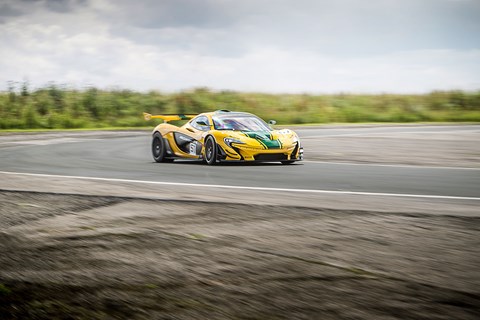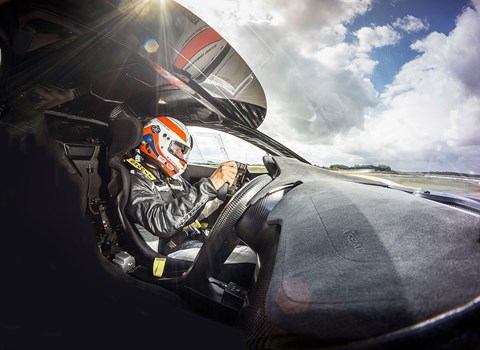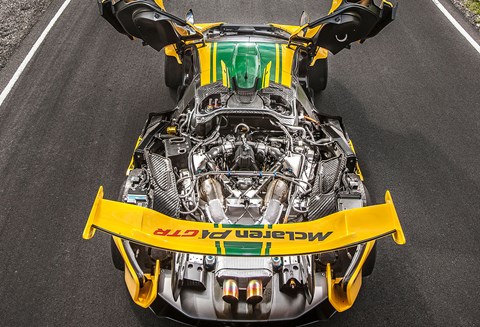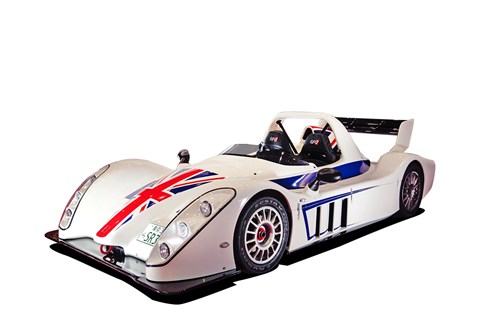► The top dog, the McLaren P1 GTR
► Martin Brundle thrashes the racecar
► Hybird hypercar gets more power
The shape bursts into view and turns towards me, evil little lights ethereal and distorted in the haze of the hot tarmac between us. Behind it the air’s a maelstrom of heat, diffuser-flung spray and, I swear, air left visibly broken by the yellow McLaren’s demanding aero. There’s a noise building too, a curious hybrid – apt – of deep V8 thunder and otherworldly jet turbine whine. Then everything drops into slow motion. With one clean input and an instantaneous response the P1 GTR switches direction. Physics is overruled before it can lodge an objection. Despite scarcely imaginable mechanical grip the car drifts into a textbook cornering attitude, its broad, alien haunches set wide in a couple of degrees of yaw. Then more noise and it’s gone, blasted from view by a slug of acceleration so prodigious the video cameraman next to me freely admits he completely failed to keep the car in frame.
That’s the problem with the P1 GTR – it’s a very difficult car to grasp, to make real, to capture in any tangible way. You could dismiss the McLaren as a £1.98-million, 986bhp, 1345kg track-only irrelevance, but it’s also the bleeding edge of performance car development. The enormous premium over the P1 yields greater rarity (49 units versus 375 P1s), another 83bhp, a 10% increase in downforce, 50kg less weight and sufficient grip, courtesy of an evolved chassis, to generate peak cornering forces 20% higher than those of the P1. All of which is either a graphic demonstration of the law of diminishing returns or, given the astonishing capabilities of the P1, a towering testament to the MTC’s speed-yielding prowess. But what does the GTR feel like, and how does it make you feel? Deadly serious instrument of laptime or, as the numbers promise, quite simply the most fun you can have in a British-built car, clothes on or off?

Eight laps in – Brundle sounds happy
‘It’s sensational through that direction change, even on overheating wets,’ he gushes. ‘You can really attack. The overriding first impressions are of a completely sorted car. Just driving from the paddock to the pits in E-mode everything works. You get the same feeling out on the track. The driving position’s fantastic, you can see out – you can’t put a high enough premium on that – and it feels sorted, like a production Mercedes that’s done a million development miles. All your conscious and subconscious barriers to pushing the car hard get a tick in the box, leaving you free to get on with driving it. Some people might call that a lack of character but I don’t agree. On the track you’re not there to work around a car’s foibles or its lack of development.’
What of the P1’s near-1000bhp powerplant? Impressive, even when you’ve driven F1 cars and Group C Jaguars? ‘It just gets up and goes. It hooks up and then… warp speed,’ says Brundle, no small hint of awe in his voice. ‘So much power, so much torque – you do have to be careful. Down the back straight it’s quite bumpy and I can feel it breaking traction now and then, even at 170mph. But the delivery is as linear as I expected. It’s just this mighty shove, with a sound going on behind you. It doesn’t make an angry noise like a race car. That’s the only thing missing for me, that crescendo you build to with a normally aspirated engine, where you can feel the torque curve; feel where the power’s at its best and where it starts to drop off. You don’t connect with this engine in the same way. Instead it’s through the palms of your hands, your backside and your right foot. I’m looking forward to getting out on slicks.’
With fierce, almost tropical sunshine baking this morning’s damp tarmac dry, McLaren technicians switch the GTR’s very secondhand-looking wets (‘The car very quickly overwhelmed its wets when the track dried, and started sliding nicely…’) for fresh slicks. There’s a telltale tightening of the belts too, and Brundle makes some changes on the steering wheel, switching out of Boost mode (which pegs power back to 790bhp, the remaining 196bhp coming in when you hit the IPAS button) for the full 986bhp under his right foot and, now that he’s done with showboating slides, opting for the mid-level ESP setting. The controls are familiar from the 650S, though in the P1 GTR they’re relocated to the wheel, which is cast from the same mould as Lewis Hamilton’s 2008 F1 wheel. Brundle’s a fan; of the wheel, of the steering – ‘I haven’t noticed it. I’m turning the wheel and the nose is going where I want it to go’ – and of the GTR’s controls generally. ‘It all makes sense. It’s intuitive, like an iPhone – you don’t need a manual.’
Brundle gets quicker and quicker with each lap
The P1’s twin Inconel exhausts once again saturate the air with noise and the sweet smell of burned 102-octane race fuel. On track the P1 GTR is visibly faster now, Brundle’s lap times tumbling first by a second a lap and then by 0.5sec. There’s the odd chirrup of ABS, the occasional flat blare of intervening ESP but mostly there’s speed – the sheer drama of an almighty machine being guided with no little commitment. This, finally, is the P1 GTR in full effect and it’s mesmerising – more fluid and balletic than the raw numbers would suggest.
‘There must be someone else out there – every time I come round on another lap someone has left another pair of long black lines onto the back straight; lovely long, even marks,’ laughs Brundle. ‘I couldn’t feel it doing that. Clearly the traction control is managing the torque and allowing a little bit of yaw.
‘It barely rolls in corners. The final frontier is a bit of understeer; deliberately I suspect, to give you a little protection. But it’s mighty through direction changes, the steering and brakes are very good and on the smoother straights the acceleration is just incredible – when you have the traction to deploy all the power, braking zones come up very quickly. The DRS function isn’t as powerful as an F1 car’s. In an F1 car DRS is just a big hand giving you an extra push – there’s no sudden spike of acceleration. Aerodynamics don’t seem to work like that. In the GTR you can feel it but it’s subtle, not like hitting the IPAS button in Boost mode. It’s interesting that we went half a second faster every lap. It confirms what I was thinking, that this is a racing car. It’s fast but it’s also consistent and accurate; there’s repeatability.

Verdict
‘Where do we go from here? I suppose it’s 1200bhp and 1000kg, and then you won’t be able to find a track to put it around. But these guys who’re paying their £1.98 million are going to have an amazing time, and they’re probably not going to lose money. The P1 is definitely digital where the McLaren F1 is analogue. There are times when you’re sitting in it and you can hear it whirring, doing things and managing things that you don’t understand, and that you’re playing no part in. But all of that vanishes when you drive and it’s extraordinary. Fun? Oh Christ, yeah.’
Still not sold? The clever stuff to help swing the £1.98million decision
Tweaked for speed
Centre-lock wheels mount to beefy GT3-style uprights. Wishbones are P1 but suspension ditches rubber bushes for pin bearings, to better cope with the increased cornering loads. Bodywork is stretched over a 30mm wider track. Screen excepted, carbon and polycarbonate replace heavy glass.
Full of fluids
P1 GTR carries 35 litres of coolant for the engine and electrical systems. P1’s aluminium fuel tank is replaced by a 57-litre bag-type tank in a carbonfibre box, fed by a race-style filler under a hatch in the roof.
Trick transmission
Ratios are as per the P1 – ‘It’s got so much torque there was no point changing them,’ explains development engineer James Hebditch. ‘For durability the pinion gear is coated in Balinit C and the gearbox uses a higher-spec lubricant.’

Formula E power
The P1 GTR’s electric motor is an uprated unit closely related to the one used in Formula E’s single-seaters. It boasts improved cooling over the standard P1 motor and reduced frictional losses to deliver a shaft output of 147kW. Crucially the P1 GTR will see off a lesser P1 easily in an E-mode race…
A little bit of F1
The interior door release catches are the same as those used in the F1 to open the luggage compartments.
Keeping its cool
Coolant is pumped through a honeycomb structure within the batteries. Fed by a low-temperature circuit linked to the vast central radiator in the GTR’s nose, the cells are kept as close as possible to room temperature – difficult when the GTR uses power-hungry Charge mode as a matter of course and is set to run at circuits like Yas Marina. Beyond 50°C power is reduced to save the cells.
Brundle’s 5 must-drive British cars

1) Radical SR3
‘The perfect track car. Around somewhere like Ascari or Barcelona they’re just brilliant. They turn-in like a racing car, and I’ve heard other F1 drivers say the same thing.’
2) Jaguar E-type
‘But it’s got to be a sorted one. Mine’s an Eagle; seam-welded with a heavy-duty engine cradle. It’s got to be a manual 4.2. E-types are brilliantly narrow and they’re beautiful, so you’re more likely to get a thumbs-up than a middle finger.’
3) McLaren F1
‘The brilliance of the F1 is its focus – there’s nothing on it that doesn’t need to be there. It’s a pure performance car. Plus there’s the racing pedigree.’

4) Jaguar XJR14
‘The best car I ever raced. Slightly underpowered perhaps but just so well balanced, so driveable I’d find myself laughing out loud. You’d go through corners like the old Bridge at Silverstone nearly flat and the car wouldn’t bat an eyelid. So you’d laugh and think, ‘Okay, I’ll take it flat.’
5) Lotus Cortina
‘It’s between this and a twin-cam Ford Escort. Dad used to sell Lotus Cortinas, so there were loads of them around when I was growing up. We used to go to Snetterton for the day to watch them race – Jim Clark out in front and sideways.’